Check out my custom vibration dampener
Tennis String Tension
Player’s Guide + Charts & Pro Tensions
We hope you love this article. Just so you know, TennisCompanion may collect a small share of sales from the links on this page to help keep this site running. Learn more.
For many players, string tension is an overlooked aspect of their tennis racquet. However, the tension at which players string their racquets can significantly impact performance and serve as an excellent fine-tuning mechanism for playing your best tennis.
Understanding string tension also allows savvy players to identify an optimal tension that enhances their game and helps with other factors, such as arm injuries and match-day nerves.
This guide will share insight into how tension impacts all aspects of racquet performance with clear explanations, a helpful chart, and a list of pro string tensions you can reference and compare.
Article Contents
Click below to jump to a section
Tap below to jump to a section
Tension Explained + Video
Tension Ranges
Low vs. High Tension
String Tension & Topspin
String Tension & Durability
Finding the Right Tension
Tension Loss Considerations
Tension for Varied Conditions
Tension & Types of String
Tension for Arm Injuries
Stringing Mulitple Racquets
Pro String Tensions
String Tension Tools
String Tension Guide
Wrapping Up
New to TennisCompanion?
Create a free account and explore my latest videos below
Tennis String Tension Explained

Tension measures the force a stringing machine pulls when installing strings, typically expressed in pounds or kilograms.
When a racquet technician strings your racquet, they’ll set a specific tension on the stringing machine. More accurately referred to as reference tension, this measures the weight applied to the string each time it’s pulled, such as 55 lbs or 24.95 kg.
Before your stringer installs strings, they’ll set their machine to the client’s desired tension. Then, as they thread and weave the strings through the frame, the machine will pull the string with the appropriate force.
It’s worth noting that while a machine will pull a string to the pre-determined reference tension, the finished product’s actual tension will differ and typically be slightly lower due to the installation process.
For example, a technician will install the main strings on a racquet first, so there isn’t any friction of the cross strings when pulling to the desired tension. However, after installing the mains, the cross strings must weave through them, imparting friction and impacting the final or actual tension. Other nuances, like the natural stretching of strings, are also a factor.
If you’re trying to decide on a tension, there’s no right or wrong answer as it’s a personal preference. However, the information in this guide will help you determine an ideal tension to ensure you get the most out of your racquet and perform your best on the court.
String Tension Video
Below you’ll find my video on the topic, which is an excellent companion to this guide.
For quick reference, here are timestamps to the different sections of the video so you can quickly jump around.
- 0:24 – Tension Explained
- 0:57 – Tension Ranges
- 1:45 – Low vs. High Tension
- 2:54 – Tension & Topspin
- 3:29 – Tension & Durability
- 3:58 – Finding the Right Tension
- 4:42 – Tension Loss
- 5:17 – Types of String & Tension
- 5:50 – Tension & Comfort
- 6:17 – Tools (Tester & Calibrator)
- 6:59 – Wrapping Up
The following sections will closely mirror the above video outline, but you’ll also find some extra content, like the string tensions of ATP & WTA pros, that I haven’t included in the video.
Recommended Tension Ranges
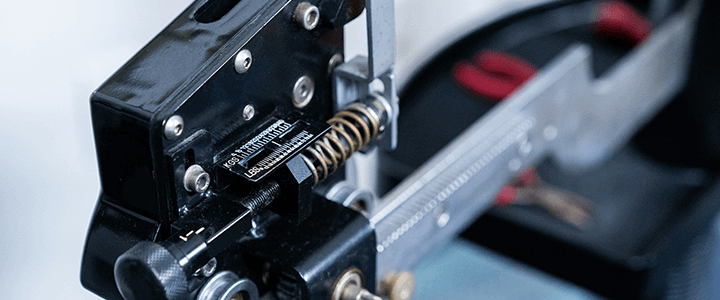
Most tennis racquets come with a recommended tension range determined by the manufacturer for optimal performance, which serves two purposes.
First, it’s the range the manufacturer has determined the racquet performs its best. However, this range is also important beyond performance because it considers the frame’s strength to ensure it doesn’t break under pressure.
Helpful Tip
The tension you choose to string your racquet is up to you, as these are purely recommendations, but it’s worth noting you may void its warranty if your string tension is determined to have caused your racquet to break.
At a high level, the recommended tension ranges across most racquets will start as low as 18.14 kilograms or 40 pounds and end around 30.84 kilograms or 68 pounds.
However, while this feels like a rather large spread, each racquet’s range typically spans roughly 5 to 15 pounds. Here’s a selection of popular racquets and the recommended tension ranges for reference:
| Racquet | Tension Range |
| Babolat Pure Strike 100 | 22-26 kg / 50-59 lb |
| Babolat Pure Aero | 22-26 kg / 50-59 lb |
| Babolat Pure Drive | 22-26 kg / 50-59 lb |
| Wilson Pro Staff RF97 | 22-27 kg / 50-60 lb |
| Wilson Clash 100 | 21-26 kg / 48-58 lb |
| Head Gravity Pro | 21-25 kg / 48-57 lb |
| Yonex EZONE 98 (305g) | 20-27 kg / 45-60 lb |
You may also find some of the tennis strings you purchase offer a recommended tension range. For example, Babolat’s RPM Blast recommends 48 – 66 lbs or 22 – 30 kg, a rough guide for understanding where they have determined the string performs its best.
Lower vs. Higher String Tension
When stringing tennis racquets, a common question for players is whether they should string with a higher or lower tension and what impact the change will have on their performance.
The simple answer is that lower tensions will give you more power, while higher tensions will give you more control. Here’s a chart roughly showcasing how tension influences performance.
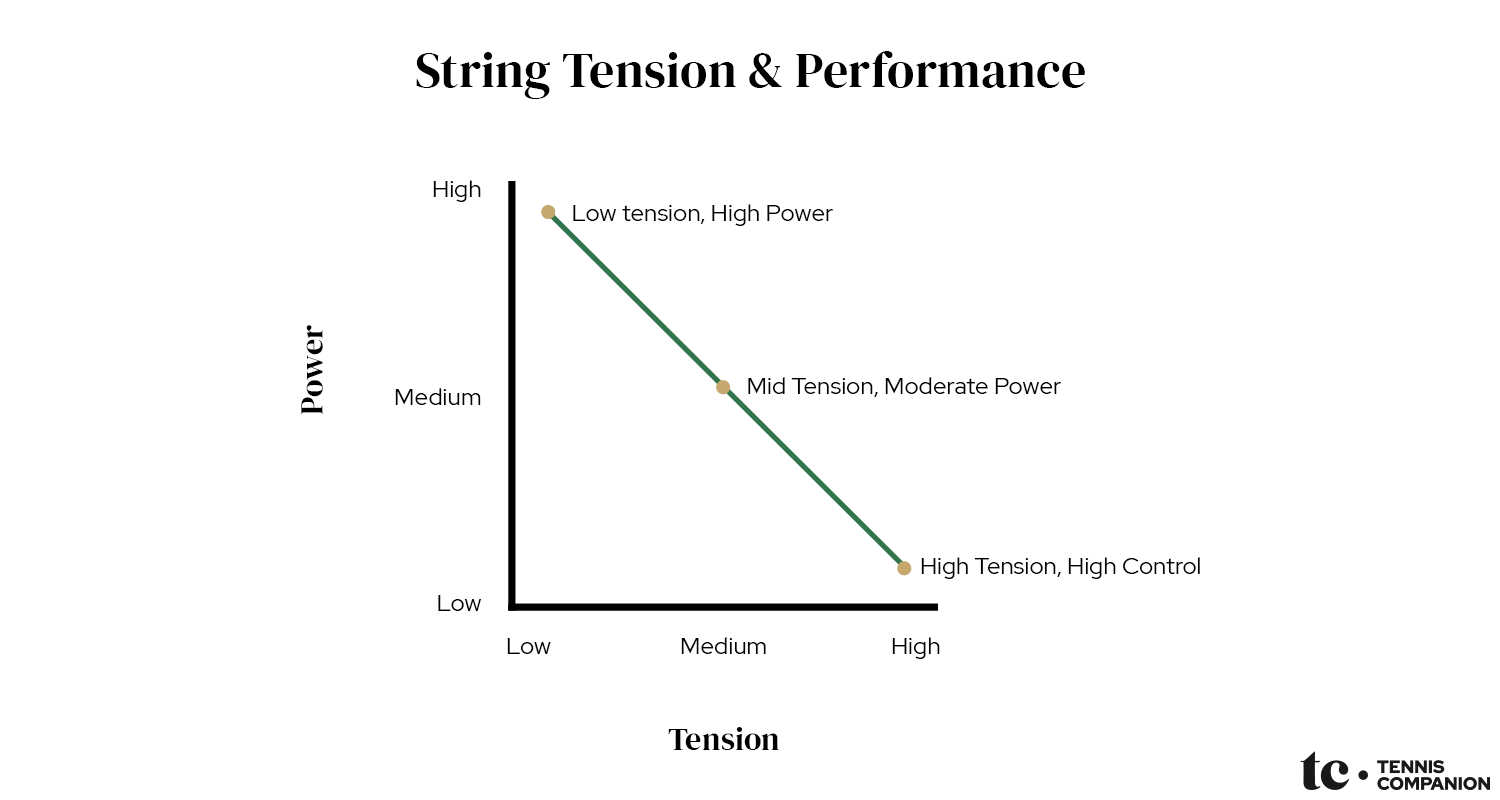
However, there’s a bit more to the equation, and it has to do with stringed stiffness, which tension influences. As we dive deeper into this topic, let’s assume all other factors are equal.
Low String Tension

A lower tension will result in more power because of a decrease in the stringbed stiffness, which impacts the trajectory or direction of the ball as it leaves your strings.
The flight path of a lower tensioned stringbed is higher, so the ball flies further and lands deeper in the court without a change in effort.
High String Tension
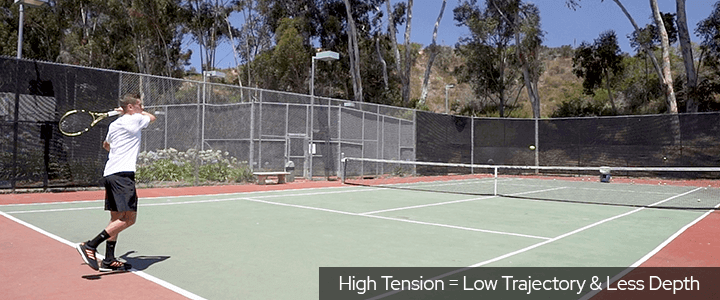
On the other hand, a higher tension will result in less power because of an increase in stringbed stiffness, which has the opposite impact on the ball’s trajectory as it leaves your strings.
More specifically, the ball’s flight path is lower, so the ball doesn’t fly as far and will land shorter in the court.
In other words, the speed of the ball as it leaves your racquet stays the same with higher or lower tensions. Instead, how fast you swing your racquet influences the ball’s speed, as studies have shown.
Of course, that can be confusing, so it’s unsurprising to suggest players string lose for power and tight for control, especially considering that’s how most players perceive changes in tension.
However, for intermediate and advanced players, that nuanced distinction between trajectory and speed is a helpful consideration to dial in optimal preferences that help yield the best results.
String Tension & Topspin
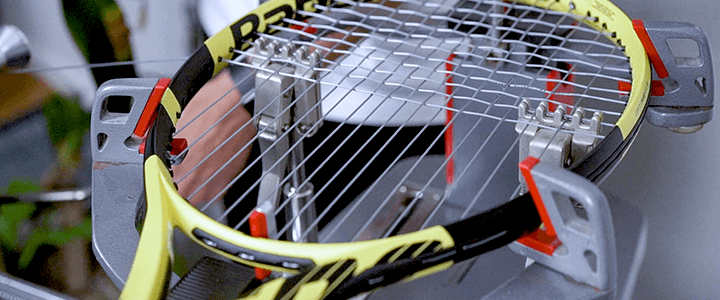
Often players will question which tension is best for topspin.
Unfortunately, to date, research has yet to prove whether or not higher or lower tensions increase topspin.
As a result, if spin is a priority, I encourage players to focus their energy on their technique and racquet head speed, which have the greatest influence, while also considering the type of string they’re using.
Polyester tennis strings significantly impact topspin due to the snapback effect as a ball brushes against them. Furthermore, a lower tension for polyester strings may improve the ability of a string to snap back and subsequently deliver more spin, which I’ve found true in my experience.
For this reason, many players use lower-powered polys. They have topspin-enhancing qualities, and more importantly, they allow the player to swing harder to increase spin without losing control.
String Tension & Durability

Another common and hotly debated question is whether higher or lower tensions increase the durability of a string.
Like topspin, the jury is still out on tension and durability. Many professionals believe lower tensions allow the strings to move more frequently and saw into each other to cause breakage. Conversely, others believe higher tensions cause increased friction when the strings move, leading to strings breaking more quickly.
While there is no definitive answer, I recommend lowering your string tension to increase durability. From my experience, strings at higher tensions move plenty, which, combined with increased friction, leads to earlier breakage than when using lower tensions.
However, like topspin, if you’re searching for durability, my primary recommendation would be to consider other variables. For example, the type of string, along with the string’s gauge or thickness, will have a more tangible impact than modifying tension.
Finding the Right Tension
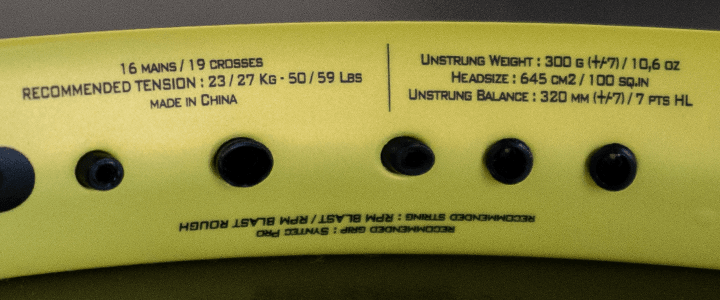
Tension doesn’t have to be a guessing game when stringing a racquet for the first time. First, start with the tension range recommended by the racquet’s manufacturer, which they’ll test with real players to determine.
You can typically find these numbers printed directly on the frame by checking the inside of your tennis racquet’s throat or on the inner edge of the frame’s head as a starting point.
The best thing you can do the first time when stringing a new racquet is to split the difference and start with the tension right in the middle of the manufacturer’s recommendation.
For example, if your racquet says the recommended string tension is 55 to 60 pounds, start with 58 pounds. Then, based on the racquet’s performance, you can adjust up or down to your preference.
Dialing in your preferred tension may take a few attempts, but you can nail it down quickly if you start in the middle. If you have more than one racquet, you can have each strung at different tensions to compare them side-by-side, which is ideal for testing.
Helpful Tip
It’s worth noting that no rules in tennis specify acceptable tension ranges. Instead, it’s entirely up to the player to determine based on personal preference.
As you work to find the ideal string tension, I recommend you stick with the same string and gauge or thickness as you adjust.
Outside of tension, various types of strings and gauges will exhibit a different feel and performance. Therefore, it’s best to stick with a single string until you find the tension you prefer.
Of course, if you eventually move to a new string, you may need to adjust your tension to accommodate the change.
Testing with Two Racquets
If you have two of the same racquet, I’d recommend you string them both fresh at different tensions so you can compare how they feel in real-time.
Of course, if you don’t have two of the same racquets, you can test two different tensions back to back. However, I suggest you restring with the new tension sooner than you typically restring. For example, after one or two weeks of hitting with one tension, cut the strings out and switch to the new tension to get the closest possible comparison.
Best String Tension
Many players ask for the best string tension for their racquet, which is entirely understandable. However, although I can provide general recommendations, what’s best is ultimately player-specific.
With that in mind, I’d encourage you to use this resource to understand how to think about tension, which you can use to identify the best tension that helps you achieve your desired performance characteristics.
Although it will take some effort upfront to learn the general concepts, you’ll benefit from the knowledge for years to come and be better equipped to adjust your tension to fine-tune your racquet.
If you’re looking for more specific tension recommendations, remember to check out my guide toward the end of this article.
Word of Caution
Players looking for more control or power often attempt to adjust their string tension to achieve a more pronounced effect. For example, an individual might increase tension by ten pounds for more control.
However, while it’s correct that increasing tension enhances perceived control, there’s a diminishing return on overall performance. In this case, increasing tension too high will likely reduce power too far, degrade comfort, and risk breaking the frame due to the added pressure.
As a result, if a significant increase in power or control is your goal, it’s worth evaluating other factors, including your technique and fitness or changing your type of strings or racquet.
With that said, think of string tension as a fine-tuning mechanism to get the most out of your racquet, string, and, more importantly, the talent you’ve developed through regular practice.
Tension Loss Considerations

After you string your racquet, it will begin to lose tension. Strings can lose up to 10% of their tension within 24 hours, so some players ask their racquet technicians to pre-stretch their tennis strings to prevent excess tension loss.
The individual stringing your racquet can manually stretch your strings by pulling the string taut around a pole or using a pre-stretch feature that they may have available if using an electronic stringing machine. Doing so can help mitigate initial tension loss after stringing.
It’s also worth noting that each type of string loses tension at different rates, and some strings are better at holding their tension. For example, natural gut and multifilament strings do a terrific job maintaining their tension, while polyester strings don’t fare as well.
As you choose a tennis string, it’s good to be aware of these qualities because they can impact the performance of your racquet and, subsequently, the frequency at which you restring.
String Tension for Varied Conditions

String tension becomes more crucial and nuanced as a player’s skill level improves and they compete at higher levels.
Beyond finding an ideal tension, players will fine-tune it according to the conditions for optimal performance. Typically, this happens during practice leading up to a match, where the players will have a good sense of what to expect.
Keep in mind that the tension changes for the following conditions are usually minor, i.e., 1-2 lbs (.5-1 kg).
Temperature
If you live in an area with prominent seasons and the weather changes substantially throughout the year, you’ve likely experienced how the ball is a bit more lively during a hot day, while it can feel almost dead on a cold day.
To accommodate, some players will increase their tension slightly during warmer conditions for more control and decrease it on cooler days for added power.
Humidity
During warm, dry conditions, a tennis ball will fly through the air with little resistance, which speeds up play. Conversely, higher humidity puts an extra drag on the ball and slows pay – tennis balls can even hold moisture from the air and sweat from players.
Once again, some players increase tension during drier conditions to improve control while they decrease it slightly to increase power. Hence, players must feel out the weather to determine how best to adjust tension for the current or expected conditions.
Surface
Each court surface plays a bit differently. The fastest is grass, hard courts fall in the middle of the spectrum, and clay courts play the slowest.
Once again, players will adjust their tension accordingly, increasing tension on faster surfaces like grass for more control and decreasing it on a slower surface like clay to enhance power, where the ball also retains a bit of debris while playing.
Altitude or Elevation
Lastly, altitude can influence the tension a player selects. At higher elevations, tennis balls are bouncier, hence the reason for high altitude balls. However, players often feel like the balls have more pop because the air is thinner and the humidity is lower, causing them to increase their string’s tension in this scenario.
When players return to a lower altitude, they’ll reduce their tension to accommodate the heavier air and humidity.
Types of Strings and Tension
Different types of tennis strings feature varying materials and construction and can exhibit dramatically different feel at the same tension. In other words, a tension that works for one string may be a poor choice for another.
For example, if you string your racquet at 60 pounds with a nylon multifilament and then switch to a polyester string and use the same tension, you’d most likely be disappointed in performance because polyesters tend to work better at lower tensions.
Let’s quickly review the different types of strings with my favorite picks in each category and notes on tension.
Natural Gut

Some of the most expensive strings on the market, natural gut strings are made from cow intestine and feature excellent power, comfort, and feel. Due to their elasticity, they do a fantastic job maintaining tension and perform exceptionally well at higher tensions.
Frequently, players that move to natural gut from synthetic materials will be inclined to string at slightly higher tensions for more control.
| Natural Gut Examples |
| Babolat VS Touch |
| Wilson Natural Guth |
Synthetic Gut
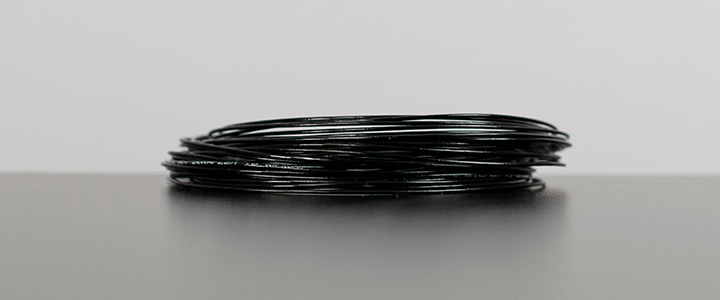
Typically made from nylon, synthetic gut strings are cost-effective for many players and offer average all-around performance with excellent performance at mid-range tensions. The performance of synthetic gut tends to suffer at lower tensions.
| Synthetic Gut Examples |
| Prince Synthetic Gut |
| Gosen OG Sheep Micro |
Multifilament
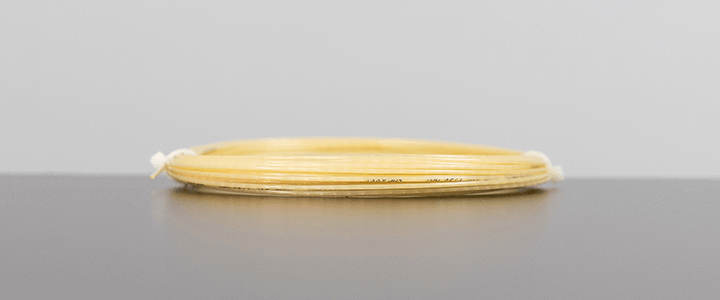
Multifilament tennis strings seek to replicate the performance of natural gut by weaving thousands of fibers together. As a result, they feature similar characteristics, including power, comfort, and feel.
Multifilaments perform well at mid to upper-range tensions, with many players stringing slightly higher due to their higher power.
| Multifilament Examples |
| Wilson NXT |
| Tecnifibre X-One Biphase |
Polyester
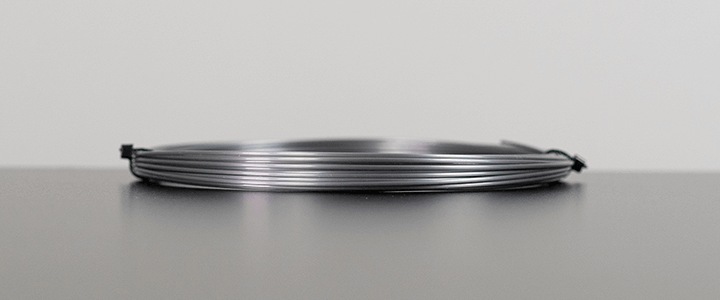
A popular string in today’s modern game of tennis, polyester tennis strings are stiff, lower-powered, and enhance topspin. Due to their monofilament construction, they also offer excellent durability.
Most players will reduce the tension of polyester strings to increase the snapback effect and comfort while allowing them to swing faster to generate added topspin.
I’ve found roughly a 10% drop when moving from synthetic gut or a multifilament to work well as a starting point. However, you’ll want to continue experimenting after the initial reduction in tension to find out what works best for you.
| Polyester Examples |
| Luxilon ALU Power |
| Babolat RPM Blast |
Kevlar

Although not as popular as they used to be, Kevlar strings are highly durable yet offer a very stiff feel. Typically, when you find Kevlar strings, manufacturers pair them with a softer string as part of a hybrid setup.
If you experiment with one of the few Kevlar strings still available, you may want to lower the tension to offset the stiffness.
| Kevlar Examples |
| Prince Classic Problend w/ Duraflex |
| Ashaway Crossfire Plus |
Hybrid
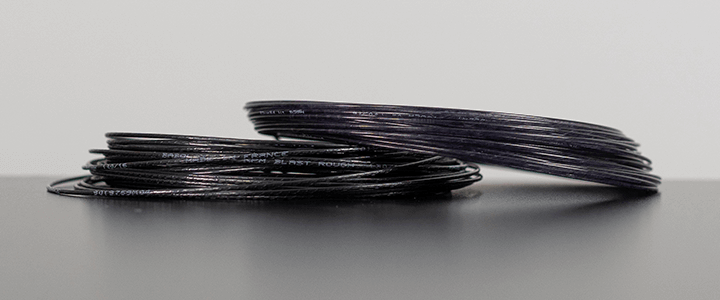
Combining two sets of tennis string, one for the mains and another for the crosses, is called a hybrid. Popular hybrids include natural gut or multifilament combined with polyester.
It’s common for players to opt for varying tensions for each of the strings, with the poly typically featuring a slightly lower tension of 2 to 3 kilograms or pounds.
| Hybrid Examples |
| Wilsons Champions Choice |
| Wilsons Duo Power |
Best String Tension for Comfort & Arm Injuries

Players with arm injuries will benefit from dropping the tension of their strings to reduce string bed stiffness, resulting in a more forgiving and comfortable response by reducing shock and vibration.
Of course, you’ll have to remember how the tension drop will influence your shot’s power or depth, as we’ve covered earlier, but it’s one avenue you can take for improving comfort.
However, don’t stop at string tension if you suffer from an injury such as tennis elbow. It can also be worth evaluating your string selection, type of racquet (including its weight), and grip size to achieve the highest comfort level. Moreover, you’ll also want to make sure you restring your racquet more frequently because as comfort-oriented strings go dead, they’ll lose these qualities.
Natural gut strings, including Babolat VS Touch and Wilson Natural Gut, are some of the best for comfort. However, the higher price and lack of durability tend to price most players out of using them.
The good news is that multifilaments like Wilson NXT and Tecnifibre X-One Biphase offer comparable comfort and are excellent options.
Stringing Multiple Racquets at Various Tensions

It’s common for players who compete at higher levels to carry three or more racquets with at least one racquet strung at a higher tension. While this may seem like a luxury to a casual player, there’s sound logic.
First, if you break a string, you want to have at least one additional backup at the same tension to continue playing. However, many players will keep one or more racquets strung a few kilograms or pounds tighter for added control and looser for extra power. Some of the pros carry upwards of ten freshly strung tennis racquets with them to every match.
In competitive situations, players will often overhit. The excitement of the match, nerves, and determination to win can make players tighten up or get overly excited and subsequently miss their shots by a small margin.
In this case, having a racquet strung tighter to regain control can be beneficial. When you’re hitting a few feet long or wide, a minor change in tension can be the difference a player needs.
String Tension and the Pros

Despite it being a personal preference, many players are keen to learn how the pros string their frames.
To that end, here’s a selection of players that draw a lot of curiosity. Here are a few things to keep in mind when reviewing these:
- Most pros will vary their tension slightly based on the conditions, i.e., a dry vs. humid climate or higher vs. lower altitudes.
- Similarly, while pro model racquets, like Federer’s Wilson Pro Staff RF97, are available for purchase, most pros use an older racquet model from the manufacturer or feature additional customizations that cater to their game for optimal performance, which influences the tension they use.
To view the entire data set for the chart below, you can scroll or swipe left to right.
| Tour | Player | String Type | Mains | Crosses | Maind Tension | Crosses Tension |
| ATP | Adrian Mannarino | Polyester | Luxilon ALU Power | Luxilon ALU Power | 11.5 kg / 25.4 lbs | 11.5 kg / 25.4 lbs |
| ATP | Alex de Minaur | Polyester | Luxilon 4G | Luxilon 4G | 22 kg / 48.5 lbs | 22 kg / 48.5 lbs |
| ATP | Alexander Bulblik | Polyester | Yonex Poly Tour Pro | Yonex Poly Tour Pro | 22 kg / 48.5 lbs | 24 kg / 53 lbs |
| ATP | Alexei Popyrin | Polyester | Luxilon 4G | Luxilon 4G | 23 kg / 50.7 lbs | 23 kg / 50.7 lbs |
| ATP | Andres Martin | Polyester | Luxilon ALU Power | Luxilon ALU Power | 23.6 kg / 52 lbs | 23.6 kg / 52 lbs |
| ATP | Andy Murray | Hybrid | Luxilon ALU Power 16L | Babolat VS Touch 17 | 28 kg / 62 lbs | 28 kg / 62 lbs |
| ATP | Ben Shelton | Polyester | Yonex Poly Tour Fire | Yonex Poly Tour Fire | 23.6 kg / 52 lbs | 23.6 kg / 52 lbs |
| ATP | Benoit Paire | Polyester | Luxilon ALU Power | Luxilon ALU Power | 24.5 kg / 54 lbs | 24.5 kg / 54 lbs |
| ATP | Brandon Nakashima | Hybrid | Baboalt RPM Blast | Babolat VS Gut | 23.6 kg / 52 lbs | 24.5 kg / 54 lbs |
| ATP | Daniel Evans | Hybrid | Luxilon ALU Power Rough | Natural Gut | 22.7 kg / 50 lbs | 22.7 kg / 50 lbs |
| ATP | Denis Kudla | Polyester | Yonex Poly Tour Pro | Yonex Poly Tour Pro | 21.8 kg / 48 lbs | 21.8 kg / 48 lbs |
| ATP | Diego Schwartzman | Polyester | Luxilon Big Banger Alu Power | Luxilon Big Banger Alu Power | 22.3 kg / 50lbs | 22.3 kg / 50lbs |
| ATP | Frances TIafoe | Polyester | Yonex Poly Tour Pro | Yonex Poly Tour Pro | 19.1 kg / 42 lbs | 19.1 kg / 42 lbs |
| ATP | Gael Monfils | Polyester | Luxilon Big Banger Alu Power | Luxilon Big Banger Alu Power | 25.9 kg / 57 lbs | 25 kg / 55lbs |
| ATP | Jack Draper | Polyester | Babolat RPM Blast | Babolat RPM Blast | 24.5 kg / 54 lbs | 24.5 kg / 54 lbs |
| ATP | Jack Sock | Hybrid | Luxilon ALU Power Rough 17 | Luxilon ALU Power Rough 15 | 15.9 kg / 35 lbs | 15.9 kg / 35 lbs |
| ATP | James Duckworth | Hybird | Babolat VS | Luxilon ALU Power Rough | 21.8 kg / 48 lbs | 20.9 kg / 46 lbs |
| ATP | Jensen Brooksby | Polyester | Solinco Outlast | Solinco Outlast | 22.2 kg/ 49 lbs | 22.2 kg/ 49 lbs |
| ATP | John Isner | Polyester | Tecnifibre Pro RedCode | Tecnifibre Pro RedCode | 15.9 kg / 35 lbs | 15.9 kg / 35 lbs |
| ATP | John Millman | Polyester | Tecnifibre Black Code | Tecnifibre Black Code | 30.4 kg / 67 lbs | 30.4 kg / 67 lbs |
| ATP | Jordan Thompson | Hybird | Babolat VS | RPM Blast | 21.8 kg / 48 lbs | 21.8 kg / 48 lbs |
| ATP | Juan Martin del Potro | Polyester | Luxilon Big Banger Alu Power | Luxilon Big Banger Alu Power | 28 kg / 62lbs | 28 kg / 62lbs |
| ATP | Kei Nishikori | Hybrid | Wilson Natural Gut 16 | Babolat VS Touch 17 | 28 kg / 62 lbs | 28 kg / 62 lbs |
| ATP | Mackenzie McDonald | Polyester | Luxilon ALU Power | Luxilon ALU Power | 20.4 kg / 45 lbs | 20.4 kg / 45 lbs |
| ATP | Marcelo Melo | Hybird | Babolat RPM Blast | Natural Gut | 18.5 kg / 40.8 lbs | 18.5 kg / 40.8 lbs |
| ATP | Marcos Giron | Hybrid | Natural Gut | Pro Stringer Blue Steel | 27.7 kg / 61 lbs | 28.6 kg / 63 lbs |
| ATP | Matteo Berrettini | Polyester | Signum Pro Firestorm 125 | Signum Pro Firestorm 125 | 27 kg / 59.5 lbs | 27 kg / 59.5 lbs |
| ATP | Max Purcell | Polyester | Dunlop Explosive Tour Spin | Dunlop Explosive Tour Spin | 22.7 kg / 50 lbs | 22.7 kg / 50 lbs |
| ATP | Milos Raonic | Polyester | Luxilon M2 | Luxilon M2 | 20 kg / 44 lbs | 20.9 kg / 46lbs |
| ATP | Nick Kyrgios | Polyester | Yonex Poly Tour Pro 125 | Yonex Poly Tour Pro 125 | 24.5 kg / 54 lbs | 24.5 kg / 54 lbs |
| ATP | Novak Djokovic | Hybrid | Babolat VS Team Natural Gut | Luxilon ALU Power Rough | 26.8 kg / 59 lbs | 25.4 kg / 56 lbs |
| ATP | Quentin Halys | Hybird | Luxilon 4G | Luxilon Element | 24 kg / 52.9 lbs | 24 kg / 52.9 lbs |
| ATP | Rafael Nadal | Polyester | Babolat RPM Blast 15 | Babolat RPM Blast 15 | 25 kg / 55.1 lbs | 25 kg / 55.1 lbs |
| ATP | Rajeev Ram | Hybird | Natural Gut | Solinco Tour Bite Rough | 25 kg / 55 lbs | 23.6 kg / 52 lbs |
| ATP | Reilly Opelka | Polyester | Luxilon ALU Power | Luxilon ALU Power | 21.3 kg / 47 lbs | 21.3 kg / 47 lbs |
| ATP | Roger Federer | Hybrid | Wilson Natural Gut 16 | Luxilon ALU Power Rough 17 | 27 kg / 59.5 lbs | 25.5 kg / 56.2 lbs |
| ATP | Sebastian Korda | Polyester | Luxilon ALU Power | Luxilon ALU Power | 22.7 kg / 50 lbs | 21.3 kg / 47 lbs |
| ATP | Steve Johnson | Hybrid | Yonex Poly Tour Pro | Natural Gut | 20.4 kg / 45 lbs | 21.3 kg / 47 lbs |
| ATP | Taylor Fritz | Hybird | Natural Gut | Head Hawk 3 | 23.6 kg / 52 lbs | 22.7 kg / 50 lbs |
| ATP | Thanasi Kokinakis | Polyester | Luxilon ALU Power | Luxilon ALU Power | 26.3 kg / 58 lbs | 26.3 kg / 58 lbs |
| ATP | Tommy Paul | Hybrid | Babolat RPM Blast 15 | Luxilon Natural Gut | 22.7 kg / 50 lbs | 24 kg / 53 lbs |
| WTA | Ashleigh Barty | Polyester | Head Hawk Touch | Head Hawk Touch | 20.9 kg / 46 lbs | 20 kg / 44 lbs |
| WTA | Caroline Wozniacki | Hybrid | Babolat Revenge | Babolat VS Team | 25.9 kg / 57 lbs | 25.9 kg / 57 lbs |
| WTA | Garbine Muguruza | Polyester | Luxilon Big Banger Alu Power | Luxilon Big Banger Alu Power | 27.2 kg / 60 lbs | 27.2 kg / 60 lbs |
| WTA | Maria Sharapova | Hybrid | Babolat VS Team | Babolat RPM Blast | 28.1 kg / 62 lbs | 28.1 kg / 62 lbs |
| WTA | Serena Williams | Hybrid | Wilson Natural Gut | Luxilon 4G | 29.9 kg / 66 lbs | 29.9 kg / 66 lbs |
| WTA | Simona Halep | Polyester | Luxilon Big Banger Alu Power | Luxilon Big Banger Alu Power | 25 kg / 55 lbs | 24 kg / 53 lbs |
| WTA | Venus Williams | Hybrid | Wilson Natural Gut | Luxilon 4G | 29.9 kg / 66 lbs | 29.9 kg / 66 lbs |
String Tension Tools
Calibrators and tension test tools are two common instruments to help with string tension measurement.
Tension Calibrators

Tension calibrators are simple spring-loaded devices that help racquet technicians ensure their machine is pulling tension accurately.
A stringing technician clamps the string end of the calibrator to one of the machine’s clamps and pulls tension, which provides a reading for comparison to the machine’s tension setting.
Depending on the difference reported by the calibrator and the machine’s settings, a stringer can dial in their stringer.
Tension Testers
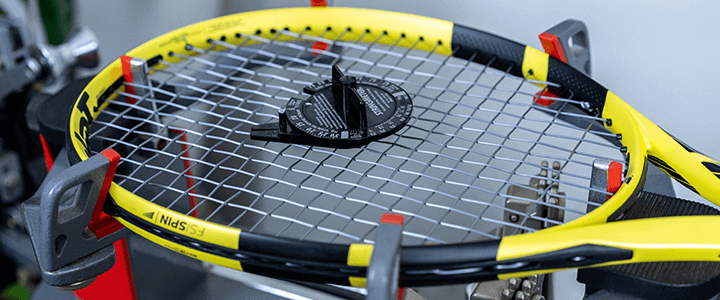
Players may want to use a tension tester to measure tension loss over time and help determine when it’s time to restring.
After stringing, measure the tension of your strings as soon as possible and then continue measuring it periodically until the frame has lost roughly 10-15 pounds of tension.
Helpful Tip
The 10-15 pound threshold can be adjusted based on your preference after using a tension tester for a while.
It’s worth noting that the tension your tester shows will not match the reference tension you asked your stringer to use when you pick up your racquet, as a racquet’s final tension will always differ. More specifically, your strings will lose tension during the stringing process.
Furthermore, tension testers aren’t highly accurate devices. Instead, they help gauge relative tension over time as a reference point to determine when to restring.
Here’s a selection of popular tension calibration and testing tools you can check out.
Tennis String Tension Guide
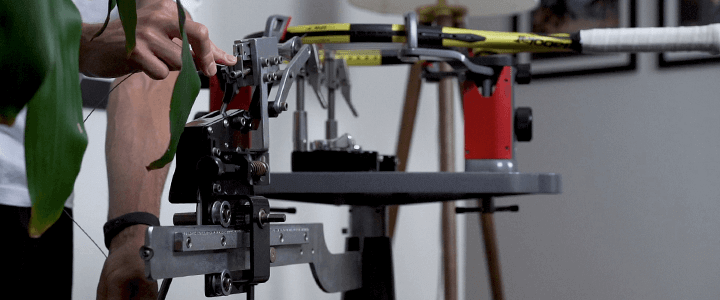
Hopefully, the information contained in this resource has helped lay a foundation for better understanding tennis string tension while guiding you to select a tension confidently for your racquet.
With that said, I recognize the information I’ve covered can be overwhelming, so in this section, I’ve provided generalized recommendations you can use as a starting point based on the type of string you’re using, your experience level, and performance goals.
Tension By Type of String
You’ll notice softer strings, including natural gut and nylon synthetic gut, and multifilaments have higher tension ranges. In comparison, stiffer strings like polyester and kevlar are lower to improve comfort.
| Type of String | Tension Range |
| Natural Gut | 50-65 lbs (22.7-27.2 kg) |
| Synthetic Gut | 50-60 lbs (22.7-27.2 kg) |
| Multifilament | 50-60 lbs (22.7-27.2 kg) |
| Polyester | 35-55 lbs (15.9-24.9 kg) |
| Kevlar | 40-55 lbs (18.1-24.9 kg) |
| Hybrid | 45-55 lbs (20.4-24.9 kg) |
Remember, the type of string you choose also influences power, i.e., a multifilament strung at the same tension as polyester will offer more power.
Tension by Performance Characteristic
Generally, I recommend players string loose for power and tight for control. Below, I’ve broken apart the broader tension ranges to align with these performance characteristics.
| Type of String | Power Tension | Control Tension |
| Natural Gut | 50-55 lbs (22.7-24.9 kg) | 56-65 lbs (22.7-27.2 kg) |
| Synthetic Gut | 50-55 lbs (22.7-24.9 kg) | 56-60 lbs (22.7-27.2 kg) |
| Multifilament | 50-55 lbs (22.7-24.9 kg) | 56-60 lbs (22.7-27.2 kg) |
| Polyester | 35-49 lbs (15.9-22.2 kg) | 50-55 lbs (22.7-24.9 kg) |
| Kevlar | 40-49 lbs (18.1-22.2 kg) | 50-55 lbs (22.7-24.9 kg) |
| Hybrid | 45-49 lbs (20.4-22.2 kg) | 50-57 lbs (22.7-25.9 kg) |
Tension for Power by Skill Level
As a player’s skill level and ability to produce racquet head speed increases, their ability to generate power will improve.
With this in mind, you’ll notice tensions for power are lower for beginners who can use the extra pace and added depth of shot and higher for advanced players who tend to generate velocity on their own.
| Type of String | Beginner | Intermediate | Advanced |
| Natural Gut | 50-51 lbs (22.7-23.1 kg) | 52-53 lbs (23.6-24 kg) | 54-5 lbs (24.5-24.9 kg) |
| Synthetic Gut | 50-51 lbs (22.7-23.1 kg) | 52-53 lbs (23.6-24 kg) | 54-55 lbs (24.5-24.9 kg) |
| Multifilament | 50-51 lbs (22.7-23.1 kg) | 52-53 lbs (23.6-24 kg) | 54-55 lbs (24.5-24.9 kg) |
| Polyester | 44-45 lbs (20-20.4 kg) | 46-47 lbs (21-21.3 kg) | 48-49 lbs (21.8-22.2 kg) |
| Kevlar | 44-45 lbs (20-20.4 kg) | 46-47 lbs (21-21.3 kg) | 48-49 lbs (21.8-22.2 kg) |
| Hybrid | 46-47 lbs (21-21.3 kg) | 48-49 lbs (21.8-22.2 kg) | 50-51 lbs (22.7-23.1 kg) |
Tension for Control by Skill Level
As a player’s skill level improves, their technique and gear will generally allow them to handle higher tensions for added control.
Beginners will also benefit from higher tension for enhancing control but should avoid stringing too tight to prevent a reduction in comfort.
| Type of String | Beginner | Intermediate | Advanced |
| Natural Gut | 55-56 lbs (24.9-22.7 kg) | 57-58 lbs (25.9-26.3 kg) | 59-60 lbs (26.8-27.2 kg) |
| Synthetic Gut | 55-56 lbs(24.9-22.7 kg) | 57-58 lbs (25.9-26.3 kg) | 59-60 lbs (26.8-27.2 kg) |
| Multifilament | 55-56 lbs (24.9-22.7 kg) | 57-58 lbs (25.9-26.3 kg) | 59-60 lbs (26.8-27.2 kg) |
| Polyester | 50-51 lbs (22.7-23.1 kg) | 52-53 lbs (23.6-24 kg) | 54-55 lbs (24.5-25 kg) |
| Kevlar | 50-51 lbs (22.7-23.1 kg) | 52-53 lbs (23.6-24 kg) | 54-55 lbs (24.5-25 kg) |
| Hybrid | 50-51 lbs (22.7-23.1 kg) | 52-53 lbs (23.6-24 kg) | 54-55 lbs (24.5-25 kg) |
Tension Guide for Popular Racquets
Every racquet has a recommended tension, so I’ve gathered some popular models for quick reference.
Babolat
| Racquet | Tension Range |
| Babolat Pure Aero 2019 (all racquets) | 50-59 lbs (22.7-26.8 kg) |
| Babolat Pure Drive 2021 (all racquets) | 50-59 lbs (22.7-26.8 kg) |
| Babolat Pure Aero 2023 (all racquets) | 50-59 lbs (22.7-26.8 kg) |
| Babolat Pure Strike Gen 3 (all racquets) | 50-59 lbs (22.7-26.8 kg) |
Dunlop
| Racquet | Tension Range |
| Dunlop CX (all but 400 & 200 OS) | 45-65 lbs (20.4-29.5 kg) |
| Dunlop CX 400 & 200 OS | 40-60 lbs (18.1-27.2 kg) |
| Dunlop FX (all but 700) | 45-65 lbs (20.4-29.5 kg) |
| Dunlop FX 700 | 40-60 lbs (18.1-27.2 kg) |
| Dunlop SX (all but 600) | 45-65 lbs (20.4-29.5 kg) |
| Dunlop SX 600 | 40-60 lbs (18.1-27.2 kg) |
Head
| Racquet | Tension Range |
| Head Prestige (all racquets) | 48-57 lbs (21.8-25.9 kg) |
| Head Speed (all racquets) | 48-57 lbs (21.8-25.9 kg) |
| Head Gravity (all racquets) | 48-57 lbs (21.8-25.9 kg) |
| Head Radical 2021 (all racquets) | 48-57 lbs (21.8-25.9 kg) |
| Head Extreme (all but Tour) | 52-62 lbs (23.6-28.1 kg) |
| Head Extreme Tour | 48-57 lbs (21.8-25.9 kg) |
| Head Instinct (all but PWR) | 48-57 lbs (21.8-25.9 kg) |
| Head Instinct PWR | 52-62 lbs (23.6-28.1 kg) |
Prince
| Racquet | Tension Range |
| Prince Chrome 100 300g | 50-60 lbs (22.7-27.2 kg) |
| Prince Hydrogen & Random (all racquets) | 50-60 lbs (22.7-27.2 kg) |
| Prince Phantom 97P | 48-58 lbs (21.8-26.3 kg) |
| Prince Phantom 100P | 45-55 lbs (20.4-25 kg) |
| Prince Phantom 100X 305g, 290g, 18×20 | 45-55 lbs (20.4-25 kg) |
| Prince Phantom O3 100X | 45-55 lbs (20.4-25 kg) |
| Prince Phantom 93P (18×20), (14×18) | 45-55 lbs (20.4-25 kg) |
| Prince Phantom 100G, 100G LB, 107G | 45-55 lbs (20.4-25 kg) |
| Prince Ripstick 100 280g, 300g | 50-60 lbs (22.7-27.2 kg) |
| Prince Synergy 98 | 50-60 lbs (22.7-27.2 kg) |
| Prince Textreme Tour 95, 100P | 45-55 lbs (20.4-25 kg) |
| Prince Textreme Tour 100L 260g, 290g, 310g | 48-58 lbs (21.8-26.3 kg) |
| Prince Textreme Warrior 100 | 50-60 lbs (22.7-27.2 kg) |
| Prince Textreme Warrior 100T | 53-63 lbs (24-28.6 kg) |
| Prince Twistpower X97 Tour, X100, x105 | 45-55 lbs (20.4-25 kg) |
| Prince Warrior 100 300g, 107 | 50-60 lbs (22.7-27.2 kg) |
Tecnifibre
| Racquet | Tension Range |
| Tecnifibre TFight (all but 305 RS) | 49-55 lbs (22.2-25 kg) |
| Tecnifibre TFight 305 RS | 50-55 lbs (22.7-25 kg) |
| Tecnifibre TF40 305 & 315 | 49-55 lbs (22.2-25 kg) |
| Tecnifibre TFlash (all racquets) | 49-55 lbs (22.2-25 kg) |
| Tecnifibre Tempo/TRebound (all racquets) | 50-55 lbs (22.7-25 kg) |
Volkl
| Racquet | Tension Range |
| Volkl ICON (all racquets) | 50-60 lbs (22.7-27.2 kg) |
| Volkl V-Cell (all but 2 & 4) | 45-65 lb (20.4-29.5 kg) |
| Volkl V-Cell 2 & 4 | 46-60 lbs (20.9-27.2 kg) |
| Volkl V-Feel (all but 1, 2, 3) | 50-60 lbs (22.7-27.2 kg) |
| Volkl V-Feel 1 | 48-58 lbs (21.8-26.3 kg) |
| Volkl V-Feel 2 & 3 | 46-60 lbs (20.9-27.2 kg) |
Wilson
| Racquet | Tension Range |
| Wilson Blade v7, v8 (all racquets) | 50-60 lbs (22.7-27.2 kg) |
| Wilson Burn v4, v5 (all racquets) | 50-60 lbs (22.7-27.2 kg) |
| Wilson Clash v1, v2 (all racquets) | 50-60 lbs (22.7-27.2 kg) |
| Wilson Pro Staff v13, v14 (all racquets) | 50-60 lbs (22.7-27.2 kg) |
| Wilson Ultra 100UL v4 | 47-57 lbs (21.3-25.9 kg) |
| Wilson Ultra v4 (all but 100UL) | 50-60 lbs (22.7-27.2 kg) |
Wrapping Up
Often overlooked, tennis string tension can be a powerful tool for the savvy tennis player and wreak havoc on the game of players who aren’t paying attention to its influence on performance.
By taking control of your string tension, you can maximize your racquet’s performance and gain an edge over a less prepared player. You’ll also be better equipped to make changes as your skills evolve.
Have questions about string tension? Feel free to add your comments below. I’ll be happy to answer any questions you may have!
Play Better Tennis
Improve your game alongside our community of tennis players
Why join?
Discussion Boards
Join the conversation with other members of the community.
5 Point Friday
Read our weekly recap of the 5 most interesting things we dig up in tennis.
Trackbacks & Pingbacks
Leave a Reply
Want to join the discussion?Feel free to contribute!

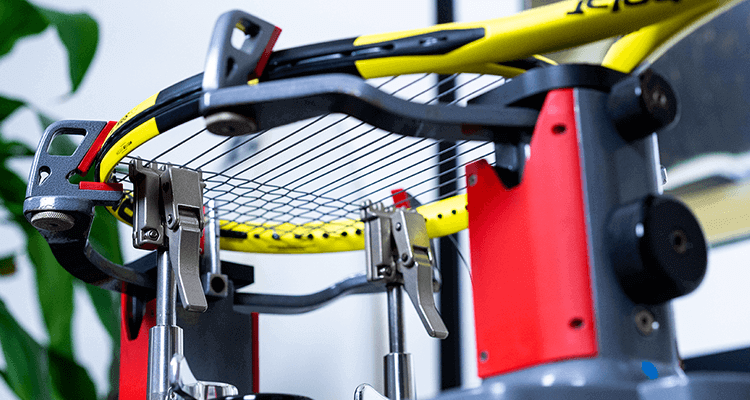

I have just ordered my first stringing machine. This article has provided some useful information. Thanks, Rick Lucas
Hey Rick,
That’s awesome to hear! Nothing beats having your own stringer, you’re going to have a ton of fun with it :)
If you don’t mind me asking, which stringer did you order?
One of my favorites… stringing, watching tennis on TV and drinking a nice cold beverage. Can’t beat it. I’m glad you found some of the information helpful and would love to hear how things work out with the new machine.
All the best,
Jon
Hi
I found your article very useful. My son who is 14, years old plays with 57 lbs tension 300 GMs rpm blast strings on babolat pure drive French open….now he wants to switch to another racquet.. He plays flat and is in between intermediate to advanced player. Any suggestions on which other racquet and what strings? Thanks in advance
Pallavi
Hey Pallavi,
Thanks for stopping by and for leaving a comment. Here are a few questions that would help me provide a more useful answer:
Looking forward to your reply.
All the best,
Jon
Hi,
I am extremely sorry for not looking up for your reply.
1 His current babolat aero drive is 305 GMs….he is finding it a bit heavy. He tried a Wilson blade and pro staff and found it much more comfortable than babolat.
He wants to have more control than what babolat gives. The strings are pro hurricane tension 60. He is looking for a light weight racquet with more control. His game is predominantly baseline, but does play good game even at the net. The strings do feel dead after just a day of being strung. He liked the feel of Wilson but is unable to choose. Once he played with a head light weight and felt good about it too. His current babolat racquet is kind of heavy for his age and is looking to switch for more control. I hope I answered your qs.
Pl guide me . I ll keep checking your site more often now.
Thanks
Pallavi
Hey Pallavi,
Thanks for getting back to me! I’d love to provide you with a more detailed comparison of the tennis racquets that your son has been using as well as some suggestions for new racquets he might want to try.
To help with this could you please provide links to the exact versions of the following tennis racquets that your son has used:
Each of these racquets have different variations with unique specifications, so in order to provide you with the best information it would be helpful for you to tell me the exact racquets your son has used.
Just head on over to your favorite online retailer and then include the links to the racquets in your reply.
I look forward to learning more!
All the best,
Jon
sir, i need job. And i want to try other company. I am a racquet stringer here in dubai. Do you know where i can find good company and i can use my work experience here. Im have 6yrs work experience as a racquet stringer.. Please help me..thank you..
Hi Michael,
Great to hear from you!
I’m don’t personally know a club or company that I can recommend. Unfortunately, I haven’t had the pleasure of visiting Dubai and getting to know some of the locals.
However, it would likely be worth trying a few searches online to see if you can come up with an opportunity for yourself – here are a few ideas to help get you started:
– tennis club
– tennis company
– tennis academy
Hopefully, if you check a few of these out, they’d turn up something for you. Best of luck in your search – let me know if I can help with anything else.
All the best,
Jon
Hi, I am 15 years old, I weigh around 60kg, skinny build, I just purchased an RF97 signature racquet, I actually don’t find the racquet that heavy as is does al the work for me haha, the strings on it feel ok, but I’m looking for slightly more power in the strings, as I play with some hard hitters..,so I’m guessing I’ll have to go lower tension? Do the strings with lower tension go tighter or looser? I once here’d that tighter strings have more power, but I could be wrong,
Thank you! :)
I might also add, that this racquet had loads of power.. But when balls come flying at you, FAST.. I’m in trouble haha, I’m a wear that it could be my strength, but if I could get different tension or strings and hit or return back hard serves/shots, I’ll be a happy person :) thanks again !
Hi Sam,
Thanks for stopping by and for the great question.
All things considered equal, lower tension will yield higher power but don’t forget along with that comes less control, so it’s usually a tradeoff. On the other hand, higher tension will produce less power and more control. If you’re looking for a bit more pop, then you can definitely play with adjusting the tension. However, another option would be to consider a different type of string. For example, multifilament strings tend to deliver higher end power so if you play with an inexpensive natural gut or polys then it may be worth investigating.
If you’d like, I’d be happy to make some recommendations. Just let me know what type of strings you’re currently using.
All the best,
Jon
Very useful article.
Thanks, Ankesh! I’m glad you enjoyed it.
On tension,
Is it ok to string my/any raqucet over the highest recommended tension and by how much?
Hi Mike,
It is okay to string your racquet over the highest recommended tension, but it’s worth noting that doing so may void its warranty, so I’d check with the manufacturer. Going ~5 lbs over shouldn’t be an issue if you’re not concerned with the warranty or if it’s an older racquet
The primary side effect could be a frame that warps or breaks due to the higher tension. I hope that helps!
All the best,
Jon
Hi,
I am purchasing a new racket wilson juice blx 100…can you tell me the best optimal tension of that raquet. Tension are from 53-63 lbs..I AM A HARD HITTER AND ULTIMATE smasher and a fair backhand
Hi there! Thanks for your stopping by and for sharing your question. You are correct, the recommended string tension for the Wilson BLX Juice 100 is from 53-63 lbs, however when it comes to which tension you should use it all comes back to personal preference. For example, you described yourself as a hard hitter. If that’s the case I’d be curious to learn whether or not you’re looking to reign in and control your power or if you really enjoy hitting hard and want to maintain as much power as possible.
If you were looking for more control I might suggest you try a tension at the upper end of the recommended stringing tension such as 61-63 lbs. Of course, if you enjoy the power and don’t have a problem with controlling the ball then you might look at stringing the racquet at the lower end of the recommended tension, perhaps 55-57.
The key is to have an initial goal in mind with your string tension and then try a tension that you’d expect to match your needs and adjust from there. It definitely takes some trial and error to find an ideal tension. Here’s a little chart for how I would look at the recommended string tension for your tennis racquet:
[Power] 53, 54, 55, 56, 57, 58, 59, 60, 61, 62, 63 [Control]
Of course, if you have any follow-up questions please don’t hesitate to ask!
~All the best, Jon
Isn’t Control and Power reversed on your chart?
Whoops! Thanks for the catch, Ron. Just updated.
~ All the best, Jon
I think Control and Power are wrongly placed in above chart.
Hi there Mrugesh! Looks like you and Ron both have a great eye :) Thanks for mentioning. I just updated the chart in one of my previous comments.
~ All the best, Jon
Sir I am deeply grateful to you for providing such useful information in a brief and crisp way. Thanks
You’re welcome, Mayank! Thanks for the positive feedback.
what is a good tension for the strings to start with
Hi Devan,
A good starting point can be found by finding the recommended string tension for your racquet and splitting the difference. For example, if it’s 50-60 lbs, you’d start at 55 lbs, then adjust up or down based on your preference. Check out this section of the article for more detail.
All the best,
Jon
Hey,
I have no idea if I’ll get a response, seeing as the next most recent comment is from 2016; however, I’m having trouble with rotator cuff tears, and I’m looking for help. I’m 18 years old ,and started playing tennis about a year and a half ago. I’m a strong competitor in level 3 tournaments. The main obstacle in my path is my blasted rotator cuffs with a history of tendinitis. I use a Pro Staff 97S tennis racquet with Luxilon Smart strings (bc of price) with the recommended tension for the strings. I have a feeling that might be part of the problem, along with extreme overworking. I just wanted to get someone else’s input on my situation.
Thanks, Owen
Hi Owen,
Sorry to hear about your arm discomfort. Regarding your situation, I’d encourage you to dig deeper into two topics: racquet weight and the type of strings you use.
Although the Pro Staff 97 S is a comfortable racquet, it’s heavy. A racquet that’s too heavy (even if it plays comfortably) can still wreak havoc on a player’s arm. Regarding strings, Luxilon Smart isn’t a bad string, but it’s a poly and, therefore, less comfortable.
Ideally, you want to play with a racquet you can comfortably swing for a few hours without it being too cumbersome or tiring. Furthermore, I’d encourage you to opt for a softer string or a hybrid that combines a more control-oriented string with one that’s comfortable.
Here are a few articles to explore:
Check those out as a starting point, and let me know if you have any follow-up questions.
All the best,
Jon
Great video! I play with a 2nd gen Pure Strike 98 16×19 and love the racket. I had it strung with Luxilon Element at mid-point tension. I find it comfortable and have no issues/concerns. I am considering buying a 2nd racket (as a backup and to have an extra one) and considering the 3rd gen Pure Strike 98 16×19. I was trying the demo and it came with Head Velocity and I found that my backhands are going deeper (good) but my forehands are going long (bad). This makes sense as this is a multifilament string with more power even though both rackets are similar in terms of weight etc. I am now ready to purchase the 3rd gen Pure Strike but a little confused about the string choice. I am leaning towards choosing same string i.e., Element but lower tension to compare? My style of play is top spin forehand, prefers to come to the net (although I am not a great volleyer) and two-handed backhand. Thanks for any suggestions.
Hi Thanirs,
Thanks for your feedback and for taking the time to ask a question.
Since you enjoy your current string, my recommendation would be to stick with Luxilon Element as your first string for the new Babolat Pure Strike you’re planning to buy.
There’s no doubt that the latest generation will feel different, but maintaining the same tension from the 2nd generation to the 3rd generation will allow you to better identify differences in feel, which you can then use to inform your decision to change the tension, keep it the same, or possibly even consider a new string altogether.
I hope that helps!
All the best,
Jon
I am 59 years Male , Recreational player using PRINCE Warrior 107 recquet
Which string will be BETTER for me ..At present using company prestrung String.. mainly baseline player …
Hi Dr. Hemant,
Check out these resources:
Consider what you like and dislike about your strings, then read these guides to learn more about each type of string to feel out which best suits your needs.
As a point of reference, you’re prestrung string is almost certainly a synthetic gut, which is a great place to start for less expensive options providing all-around performance.
Of course, if you’re reviewing any of these articles, don’t hesitate to ask questions if you have them. I’d be happy to help.
All the best,
Jon
Hi Jon,
First of all I commend you on a great site and some really great insight into tennis, thank you.
I am 45 years old, and played tennis as a kid (started at the age of 13 and played till the age of 18-19) and then hung up my racket until a year ago when I started again. I currently use a Babolat Pure Drive at 300 grams, the 2019 model, 100 sq inch head, 16/19, and have it strung at 25kg/24kg with monofilament strings.
My game is mostly baseline, I do like to come to the net but find I don’t have the stamina to keep doing it on a regular basis, my 1st serve is flat and second is a kick or a spin, and I found that my Babolat gives me way too much power, where I am constantly putting the brakes on my shots in order to have the ball stay inside the court. I feel like I am playing with 70% swing speed in order to contain the shot.
Now, I am in search of a new racket, and primarily because of arm tension, and Babolats stiffness rating. Over the last month I have read reviews and tested numerous rackets from friends at my club. Among the rackets that I tested are:
* Tecnofiber TF40 – 98sq head 18/20 strings at 23/22 – I found it to be top spin unfriendly
* Tecnofiber TFight 315 16/19 – strung at 25/24 – I found this racket very good, top spin friendly, I felt I could hit with a 100% effort and the ball would stay in the court.
* Yonex ezone 100 16/19 strung at 24/23 – I found this racket to be really good in the control department, and very solid feeling. At times it would fly uncontrollably off the string bed, but I suppose more concentration on shots would get that under control.
* Head pro speed – didn’t like it.
* Yonex Vcore 98 – ???
I am about to test the Yonex vcore 98 from 2019 – and I would like to give myself the chance to set it up like the TFight 315, where I am able to hit the ball with power and topspin without it sailing long.
The specs of the TFight 315 and the Yonex vcore are very similar and I would like to replicate the feeling of the TFight in the Yonex, therefore I was thinking of stringing it to 25 kg approximately and testing it out. Can you please advise me if I have taken everything into consideration and if there is something I overlooked?
Regards,
James
Hi James,
Regarding your question, my main concern regarding your move to the VCORE 98 and TFight 315 are the stiffness ratings because you mentioned you’re looking for a new racquet due to “arm tension.” Although these racquets are slightly less stiff, they’re still on the higher end of the spectrum.
As a starting point, I’d encourage you to check out my guide on racquet stiffness. From there, you can zero in on a few racquets that provide comfort, then hunt down those within that category that are lower powered, while providing plenty of spin (this seems to be important to you).
Examples that come to mind include the Wilson Blade 98 16×19 and Head Gravity MP. You’re doing a lot of research, which is excellent, but it appears you might be overlooking the comfort element, which is part of why you shared you’re looking to change racquets.
Best of luck!
Jon
Hi! Great info and explanations!
I returned to the game after 25 years. Yes you read that right! Can’t believe it myself. Well, now I’m more hooked than I ever was.
So here’s my question to make sure I am understanding the string tensions correctly:
I came back and played a bunch of Doubles and Mixed doubles for a couple of years. Now that I feel my MoJo back and now that I feel ready to take on some of the hard-hitting youngsters, I’m thinking of adjusting my racquets for my two types of games.
I play with the Head Radical 360 Graphene racquets.
Since my doubles matches are more about control and placement, I use the RADICAL S model ( a more forgiving racquet) with a 57 lbs ( the highest recommended by Head) and with all Natural Gut.
My singles matches are usually vs hard hitting players with a fast pace of game. I plan to use my RADICAL PRO model with a lesser number, Maybe something between 48-52 (not entirely sure, would still need to try it out) and using Hybrid. Using your tables, thinking of natural gut and Luxilon Power. Not sure what kind of a difference it makes when using one for main and another one for crosses.
??
Am I going in the right direction? Does this make any sense?
Thanks for sharing all your knowledge!
– Tennis Ol’ Guy
Hi Miguel,
Conceptually, the premise of adjusting your string tension to align with the type of tennis you’re playing is practical, especially if it leads to the performance you want to achieve. However, the biggest downside for most players taking that approach would be the adjustment, moving from one racquet to the next, along with the variance in tension.
My favorite part of what you’re sharing is the experimentation, which most players shy away from or don’t consider. If it were me, I’d use the same racquet with a 2-3 lb adjustment from one to the next, so it’s not too jarring as I transition between singles and doubles.
When stringing hybrid, the mains will dominate the overall feel, so use the string that offers the primary performance characteristics you desire. As a point of reference, most pros string natural gut in the mains and poly in the crosses, but you’ll find players taking the opposite approach – it’s a personal preference. If you want to dive deeper into hybrid stringing, check out my article on the topic.
I hope that helps!! Good luck, and thanks for stopping by and sharing.
All the best,
Jon
That was a great article, really took the time to go in depth.. And with numbers!! Thank you
Thanks, John! Glad you enjoyed it.